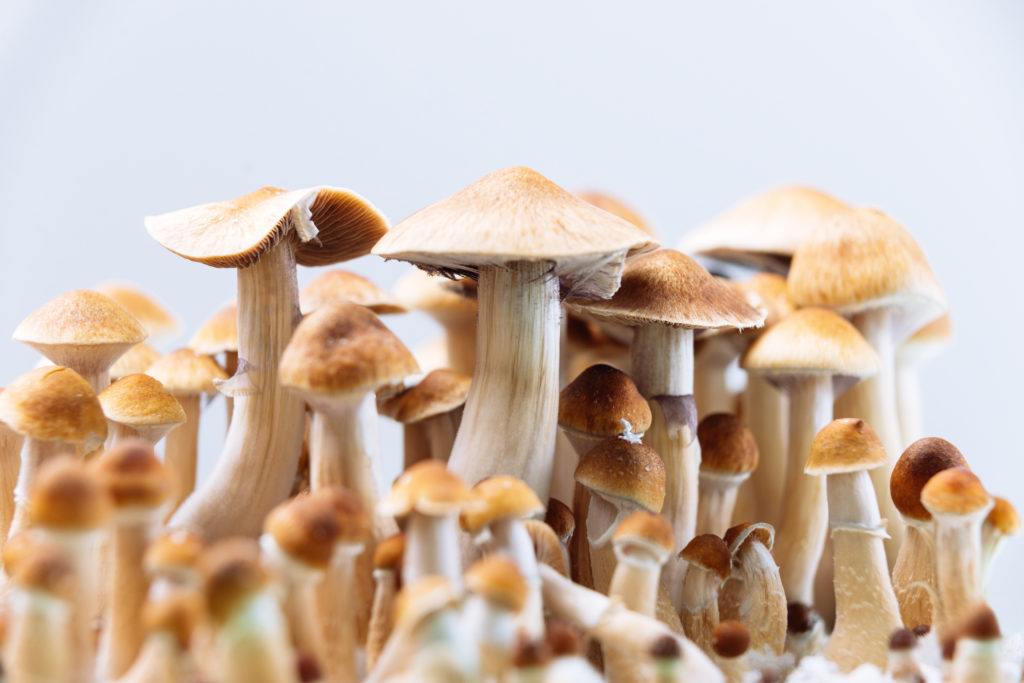
Reading through discussion boards on sites like Reddit indicates there is some controversy and misinformation on what a casing layer is and the pros and cons of using one for growing gourmet, medicinal, and psychedelic mushrooms.
There are several classic mushroom cultivation books that have come out over the years, including The Mushroom Cultivator by Paul Stamets and J.S. Chilton1 and the Psilocybin Magic Mushroom Grower’s Guide by O.T. Oss and O.N. Oeric2 (aka Dennis and Terence McKenna). These two books devote sections to discussing casing layers and their importance in the biology of mushroom growth and development.
What is a Casing Layer?
Basically, a casing is a layer of material added on top of a bulk substrate that is already colonized by mycelium. It is often a non-nutritive material such as vermiculite, peat moss, or coconut husk fiber. There is a misunderstanding on some mushroom discussion boards that the casing is a layer of bulk substrate that is placed on top of the uncolonized mixture of grain spawn and substrate. To avoid confusion, one might call this a ‘topping off’ layer instead.
The Benefits of a Casing Layer
Not all mushroom species require a casing layer. But in the words of Stamets and Chilton,
In all species where the use of a casing has been indicated as optional, yields are clearly enhanced with the application of one.
Stamets and Chilton describe the four essential functions (benefits) of the casing layer as:
- Protecting the colonized substrate from drying out.
- Providing a humid microclimate where mushroom primordia can form and develop.
- Creating a water reservoir for the mushrooms as they grow and mature.
- Supporting the growth of beneficial microorganisms.
All other growing conditions being met, these four benefits add up to optimization of the environment, and hence, setting up the grow to maximize the yield of mushrooms.
Understandably, many psychedelic mushroom growers are thrilled when their first flush (crop) yields five giant mushrooms, for example. If each fresh mushroom weighs 50 grams (g), the total flush is 250 g. Once dried, their weight becomes about one-tenth (mushrooms are about 90% water), or 25 g. Not bad for the time, effort, and money invested. And if conditions allow for one or two more flushes, all the better.
But according to Stamets and Chilton, yields can be much higher if all growing conditions are optimized, including using a casing layer. Take, for example, Psilocybe cubensis. Stamets and Chilton say its yield potential is 2-4 pounds of fresh mushrooms per square foot over five weeks of cropping (growing).
Putting this in perspective, a shoebox-sized 6-quart plastic tub (a typical size used by growers) has about 0.78 ft2 of surface area. A harvest of just one pound (about 454 g) would result in 345 g of fresh mushrooms, equivalent to about 34.5 g dried (this is about 10 g more than the big mushroom example).
Doubling that wet weight to meet the lower end of the Stamets-Chilton range yields about 71 g of dried mushrooms. Therefore, the potential yield is almost 3X greater than the ‘5 huge mushrooms’ example given earlier (assuming they were grown in a tub with similar square footage). All that from just one flush. Of course, this is a purely hypothetical comparison. There are many other variables at play when growing mushrooms other than the use of a casing layer.
Added Time is the Major Drawback
Mushroom growers want results fast, and pretty much everyone can empathize with that feeling of impatience in one way or another. Adding a casing layer creates another step, adding time in the mushroom growing process. This is likely one of the main reasons many hobby growers choose to skip it. Several more days (perhaps weeks, depending on the depth) are needed for the mycelium to grow up through the casing and colonize/form primordia.
There’s also the risk of a condition called overlay. This occurs when the mycelium overruns the casing layer and creates a dense growth that hinders the formation of pins (Oss and Oeric call it “…a thick spongy crust”). An overlay can be triggered by growing conditions that escape the cultivator’s eye, so extra vigilance is required with a casing layer.
Also, if a grower chooses to pasteurize the casing layer before application, this adds even more time. Not to mention that adding a layer of material to the grow also presents opportunities for contamination, even if it has been pasteurized.
There is also the increased cost of materials to consider. A casing layer that is 2 inches thick multiplied by several large growing tubs can add up quickly.
The Mushroom is In the Eye of the Beholder
Adding a casing layer to a colonized magic mushroom substrate doesn’t take a lot of physical effort. However, it is important to consider the situation and resources available to the mushroom grower, regardless of whether they are growing a psychedelic genus or not. Using a casing layer properly takes some planning, extra time and attention, and a healthy dose of patience. Not everyone can work those requirements into their daily lives. However, more significant quantities of healthy mushrooms may be awaiting those who can incorporate a casing layer into their cultivation plan.

Has anyone every done a comparative study on different types of casing layers? Is it advisable to soak/saturate the casing layer prior to adding it to the grow?
Im sure someone has, it also depends on the type of mushroom. Ive worked with several different types without a casing layer, but also noticed the ones that definitely needed it.
Great stuff to know thank You ????